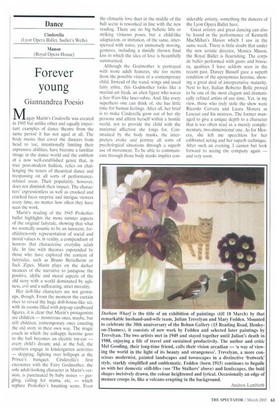Forever young
Giannandrea Poem()
Maguy Mann's Cinderella was created in 1985 but unlike other and equally important examples of dance theatre from the same period it has not aged at all. The body masks that cover the dancers from head to toe, intentionally limiting their expressive abilities, have become a familiar image in the dance world and the emblem of a now well-established genre that, in true post-modern fashion, relies on challenging the tenets of theatrical dance and trespassing on all sorts of performancerelated areas. Their popularity, however, does not diminish their impact. The characters' expressionless as well as crooked and cracked faces surprise and intrigue viewers every time, no matter how often they have seen the work.
Mann's reading of the 1945 Prokofiev ballet highlights the more sinister aspects of the original fairytale, showing that what we normally assume to be an innocent, forchildren-only representation of social and moral values is, in reality, a compendium of horrors that characterise everyday adult life. In line with theories expounded by those who have explored the content of fairytales, such as Bruno Bettelheim or Jack Zipes, Mann plays on the darker nuances of the narrative to juxtapose the positive, idyllic and moral aspects of the old story with a world dominated by ugliness, evil and a suffocating, strict morality.
Her doll-like characters are not grownups, though. From the moment the curtain rises to reveal the huge doll-house-like set, with its rooms filled with pop-up cardboard figures, it is clear that Mann's protagonists are children — monstrous ones, maybe, but still children, contemporary ones enacting the old story in their own way. The magic coach in which the unhappy heroine goes to the hall becomes an electric toy-car — every child's dream; and, at the ball, the courtiers engage in kindergarten activities — skipping, fighting over lollipops at the Prince's banquet. Cinderella's first encounter with the Fairy Godmother, the sole adult-looking character in Mann's version, is punctuated by baby noises — gurgling, calling for mama, etc. — which replace Prokofiev's haunting score. Even the climactic love duet in the middle of the ball scene is reworked in line with the new reading. There are no big balletic lifts or striking virtuoso poses, but a child-like adaptation, or imitation, of the same, interspersed with naive, yet immensely moving, gestures, including a timidly thrown final kiss in which the idea of love is beautifully summarised.
Although the Godmother is portrayed with more adult features, she too stems from the possible vision of a contemporary child. Instead of the wand, wings and usual fairy attire. this Godmother looks like a martial-art freak, an alien figure who waves a Star Wars-like laser-sabre. And, like every superhero one can think of, she has little time for human feelings. After all, her brief is to make Cinderella grow out of her shy persona and affirm herself within a hostile world, not to provide the child with the maternal affection she longs for. Constrained by the body masks, the interpreters evoke and portray all sorts of psychological situations through a superb use of movement. To be able to communicate through those body masks implies con
siderable artistry, something the dancers of the Lyon Opera Ballet have.
Great artistry and great dancing can also be found in the performance of Kenneth MacMillan's Manon which I saw in the same week. There is little doubt that under the new artistic director, Monica Mason. the Royal Ballet is flourishing. The corps de ballet performed with gusto and bravura, qualities I have seldom seen in the recent past. Darcey Busse11 gave a superb rendition of the eponymous heroine, showing a great deal of interpretative maturity. Next to her, Italian Roberto Bolle proved to be one of the most elegant and dramatically refined artists of our time. Yet, in my view, those who truly stole the show were Ricardo Cervera and Laura Morera as Lescaut and his mistress. The former managed to give a unique depth to a character that is too often read as a merely complementary, two-dimensional one. As for Morera, she left me speechless for her calibrated acting and her superb technique. After such an evening, I cannot but look forward to seeing the company again — and very soon.


















































































 Previous page
Previous page